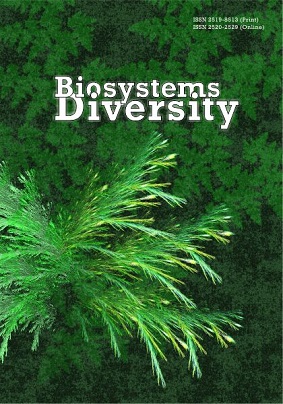Рекреаційна трансформація трав’яного ярусу лісів урбоекосистем Центрального Поділля
Recreational transformation of the herbaceous layer in an urban forest ecosystem of Central Podolia
Author(s): O. I. BlinkovaSubject(s): Sociobiology, Environmental interactions
Published by: Дніпропетровський національний університет імені Олеся Гончара
Keywords: vegetation; eсomorph; biomorph; ecological valence; phytodiversity; phytoindication;
Summary/Abstract: This article examines the impact of recreational activities on herbaceous cover of forests on the example of an urban environment in Central Podolia. The features of changes in environmental conditions of ecotypes of an urban forest have been shown through the systematic, biomorphological and ecomorphic structure of the herbaceous cover, the ratio of ecological groups, changes in type of ecological strategy of species, assessment of ecological fractions valences, and phytodiversity. We found 78 species of vascular plants. The most diverse families are Asteraceae, Poaceae and Lamiaceae. The biomorphological range of phytodiversity of the intensive recreational zone is characterized by a high proportion of adventive and ruderal species, dominance of vegetative mobile species, forming of monodominant groups and disturbed distribution of all spectrum types for coenotic morphs. Perennial hemicryptophytes dominate in the spectrum of life forms. The share of therophytes increased along the gradient of recreational transformation. Unrosellate herbal plants dominate in the structure of aboveground shoots and leaf placement, plants that don’t have special modifications dominate in the structures of underground shoots. Helophytes dominated in the analysis of heliomorphic plants. Mesophytes dominated almost everywhere. The share of hydrocontrastophobes increased with a gradual removal from places of recreation. Changes in acidomorphic and nitromorphic structures of plants were not found. Types of transitional groups of ecological strategies, including CR-, CS-, and CRS-strategies prevailed. The share of patiens diminished. Exsplerents from all types of primary ecological strategies dominated. Analysis of ecological valence fractions showed that species of hemi-euryvalent and euryvalent fractions dominate among hydromorphes, hemi-euryvalent species dominate among ecogroups of scale variability humidification of soil, hemystenovalences species dominate among trophomorphes. Euryvalenct fractions were absent in soil aeration ecogroups. The overall measure of phytodiversity is at its maximum in the zone of weak recreational transformation.
Journal: Biosystems Diversity
- Issue Year: 25/2017
- Issue No: 2
- Page Range: 82-88
- Page Count: 7
- Language: Ukrainian

